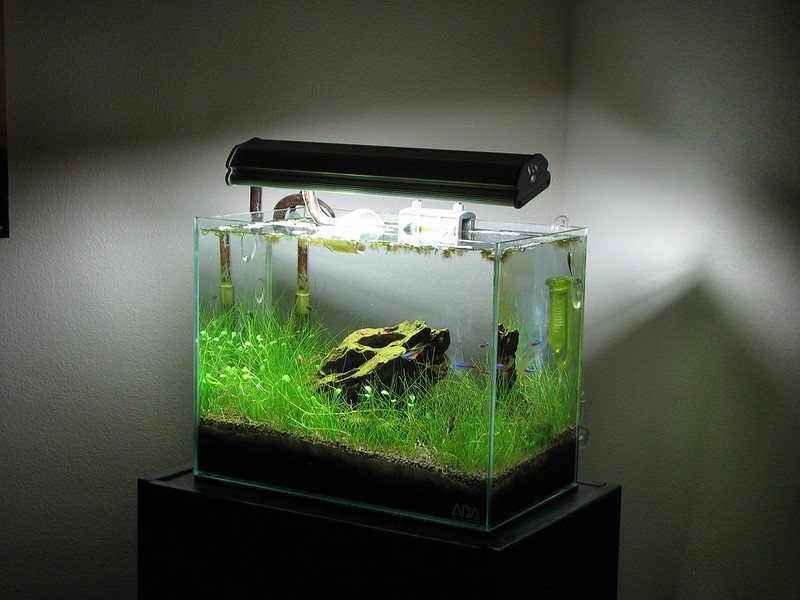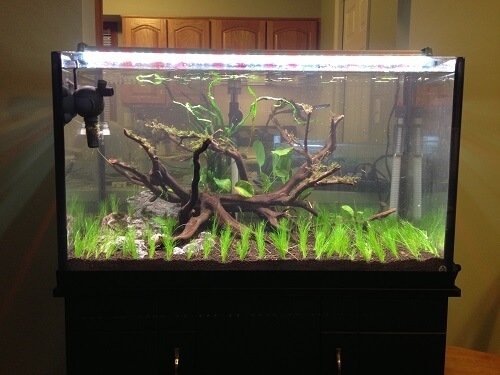If you’ve been toying with the idea of upgrading the esthetics of your tank by adding greenery, then you’ll do well by picking dwarf hairgrass.
It’s a relatively easy plant to grow and maintain for beginner and experienced aquarium owners alike, and it gives a beautiful tiered, 3D effect to your tank when trimmed and shaped correctly.
This guide will help you understand all you need to know about the plant, from its origin to how to plant, grow, and use it in your tank.
Overview
- Scientific Name: Eleocharis acicularis, Eleocharis parvula
- Family: Cyperaceae
- Order: Poales
- Genus: Eleocharis
- Care Level: Easy
- Growth Rate: Rapid/1-2 inches per month
- Maximum Size: 6 inches (15 centimeters)
- Water Conditions: 50° to 85° Fahrenheit (10 to 29°C), 6.5 to 7.5 pH, 2-10 KH
- Lighting: Moderate/2 watts per gallon
- Propagation: Runners
- Tank Placement: Carpet
What Is Dwarf Hairgrass?
Dwarf hairgrass is an aquatic carpeting plant commonly used by aquarists and tank owners as an aquascape plant, i.e., to carpet tanks, and gives them a more natural and wild look.
Dwarf hairgrass is scientifically known as either Eleocharis acicularis or Eleocharis parvula. These two species belong to the Cyperaceae family under the order Poales. These species are scattered all around the world, from the two Americas to Europe and even Asia.
They grow in countries such as Russia, Cuba, Brazil, Canada, Mexico, Japan, Vietnam, and specific parts of China and Indonesia. They can grow in freshwater, brackish water, and even saltwater.
They’re usually located in marshes, bogs, and mudflats, where they grow in shallow waters due to their requirement of abundant light and carbon dioxide levels.
Dwarf hairgrass is the water equivalent of regular grass and is described to look like green spikelets, needles, or hair, hence the name hairgrass or the less common spikerush. It can reach its maximum length of 6 inches (15 centimeters) in a few short months, but on average, it grows up to about 4 inches.
Caring for Dwarf Hairgrass In Aquarium

Tank Size
No specific tank size is required for dwarf hairgrass. It can grow in any given tank size, starting from 10 gallons, with adequate and regular care.
However, keep in mind that the bigger the tank, the more stable the water parameters, which is better for your plant’s health and growth.
Water Parameters
- Temperature: 50° to 85° Fahrenheit (10 to 29°C)
- pH: 6.5-7.5
- Water Hardness: 2-10KH
You need to regulate the following three essential water conditions for the optimum growth of hairgrass; temperature, pH, and water hardness.
Thankfully, when it comes to temperature, dwarf hairgrass isn’t too picky, which explains its wide distribution around the globe. It can survive in cool waters, unlike other plant species. The ideal temperature for growing a healthy dwarf hairgrass ranges from 50° to 85° Fahrenheit (10 to 29°C).
As for the pH, it prefers a neutral environment, so try and keep your tank’s pH in the 6.5-7.5 range.
Lastly, the water hardness can somewhat vary from soft to moderately hard, so it’s best to have your water’s minerals levels at 2-10 KH.
The key to aquarium life is stable conditions, as swinging water parameters are one of the biggest killers of any tank’s communities, from plants to fish.
Therefore, when it’s time to change the tank’s water, take extra care to achieve a temperature, pH level, and hardness level similar to the tank’s preexisting water. This is done in increments by changing only a quarter of the water once a month or a smaller amount in a shorter time span.
This gradual change ensures that no extreme changes will occur in the water conditions and the nitrogen cycle isn’t affected, thereby protecting and preserving your dwarf hairgrass and other tank occupants.
To learn how to control your tank’s pH, follow this guide, and for a more in-depth understanding of the nitrogen cycle and how to cycle your tank, click here.
Lighting Conditions
Dwarf hairgrass needs moderate amounts of light to be able to carry out the process of photosynthesis.
It can’t photosynthesize and grow in the shade, unlike some other water plants, so make sure that it’s in the direct path of your light and there are no obstructions to impede the light’s reach.
Most standard or LED tank lights do the trick, where about 2 watts per gallon of water are sufficient for the plant’s growth.
Substrate & Fertilizers
When it comes to a substrate that’ll support the growth of dwarf hairgrass, the finer and more like sand, the better. That’s because the small grains allow the roots to fully spread and extend through them without damaging the delicate roots.
Bigger and more rough substrate varieties, such as gravel, will still allow dwarf hairgrass to sprout to a degree, but it’ll be a slow and arduous process for the plant.
So, a layer of fine substrate -not exceeding 1.5 inches- should be spread all across the tank floor. Ideally, it should contain and release macronutrients needed by the plant, such as phosphorus, nitrogen, and potassium.
Suppose you can’t get your hands on a nutrient-loaded substrate. In that case, other means of nutrition delivery are available, including root tabs and liquid fertilizers.
For optimal growth rates and patterns, you can place a layer of aquatic plant soil below the substrate. A supply of carbon dioxide further encourages plant growth. This can be delivered through a carbon dioxide tab or injection of 30 ppm ( about 1-3 bubbles/second).
While dwarf hairgrass can grow and flourish with no extra carbon dioxide in the presence of good light and nutrition, the booster dose of carbon dioxide accelerates the plant’s growth rate, shunts that of algae, and develops a more bright and vibrant green color.
How to Plant Dwarf Hairgrass?
As long as direct light is provided, it’s a relatively uncomplicated process to plant and grow a dwarf hairgrass plant. However, before you take to it, you should decide what look you’re going for.
If you want a lush, full carpet of greenery, then planting should be done in tight groups, where every patch of blades is apart from its companion by about 1 to 2 inches. Imagine a 2-inch sided square, around which you’ll place a patch at every corner and one at the center.
If you’re going for a more sparse and scattered look, then plant the tufts away from each other in the places you think are appropriate.
As soon as you’ve decided on the appearance you desire, section the hairgrass into patches of 4-6 blades and trim the already established roots. This ensures that the new roots aren’t overcrowded and can grow fast together with the superficial blades.
You can also cut short the preexisting blades of grass if you want a more neat/cultivated look. That’s because dwarf hairgrass has a memory-like function that remembers its original shape and length. So if you cut it short, it grows slowly and shortly, while if you leave it untrimmed, you’ll have an untamed jungle, so to speak.
Next, grab your tweezers and gently place each patch 1 inch into the substrate, making sure the root is fully buried. Don’t forget to shake your tweezer before retracting it so that the substrate moves and arranges itself around the plant.
Maintenance
Fortunately, dwarf hairgrass doesn’t cause much of a hassle when it comes to maintenance.
As stated above, once the plant is established and fully grown, all you have to do is trim the blades of grass to the length that suits your taste.
If you’re still in the process of establishing a carpet, i.e., the horizontal spread phase, then cut the blades down to 1.5-2 inches to further fasten the process.
Just know that hairgrass plants can grow pretty quickly compared to other plant types, so expect regular trims to be in the books. No worries though, you’ll become pretty proficient at cutting it in no time.
When the plant fully covers your tank floor, you can get more artistic with your trimmings. For example, some tank owners cut only the strands at the front while leaving those at the back. This gives them an unimpeded view of the tank and its occupants yet, still providing a hideout for fish in the back.
If you find that your hairgrass has stunted growth or looks to suffer from an uncontrolled algae invasion, there are a few things you can check and do to fix these issues.
First, check your water conditions and make sure they’re all within the required ranges. If that’s in the clear, then it’s probably a lack of light, nutrients, or carbon dioxide. All of these can be easily corrected by giving supplements and ensuring that tank decorations aren’t subduing the light.
If algae growth is out of hand, that translates to a shortage of carbon dioxide or an excess of light and nutrients. Manage these circumstances to the best of your abilities and get some algae-eating/bottom-dwelling fish to rid yourself of the pest.
Pro tip: A decent current will allow your hairgrass to thrive and flourish because it prevents algae spores from sticking to the plant and germinating.
Propagation
Dwarf hairgrass is a runner, meaning that it grows by sending slender horizontal offshoots from the root -aka runners- into the substrate. These runners then sprout leaves as they grow from the root up.
These runners are regularly and frequently produced, meaning they’ll spread all over the tank floor in no time.
Although you can’t personally control the hairgrass’s amount of propagation, you can certainly speed or slow down the process.
That’s achieved by increasing or decreasing the temperature because the higher the temperature is (still within the acceptable range), the faster the plant will grow.
How to Use Dwarf Hairgrass in an Aquarium?

As previously mentioned, dwarf hairgrass can be used for either fully carpeting your tank or dotting the aquarium as a decoration among the monotonous rocks, caves, and substrate.
Either way, It adds color and movement to the aquarium in a way fake plants can’t. Other than its appearance, it serves multiple purposes, such as regulating the nitrogen and toxin levels, producing oxygen, and acting as a source of nutrition for your fish and other aquatic creatures.
It also provides a shelter for bottom-dwelling species as loaches and catfish, where they can rest and spawn without fear of exposure. All in all, it’s a great plant to have in your tank.
How to Choose Healthy Dwarf Hairgrass?
Dwarf hairgrass is readily available in almost all aquarium stores and sold as tufts in small pots; however, you can’t just pick any pot ahead of you and call it a day.
A damaged plant won’t develop well if it all, and you would’ve thrown your money down the drain. So you have to look for certain features that ensure the plant is healthy and will grow nicely.
First, look for any brown discoloration in the leaves. That means the plant can’t photosynthesize and on its way to the afterlife.
Also, the plant should be able to support its own weight without any drooping leaves. If it can’t stand on its own, it may have a hard time acclimating and surviving in the new environment.
Lastly, check for sound, whole, long, white roots. Short roots can’t absorb the needed nutrients, similar to brownish damaged or torn roots.
Should You Add Dwarf Hairgrass To Your Tank?
Dwarf hairgrass makes for an excellent addition to any hobbyist’s tank due to the great result it provides when compared to the effort it takes to maintain.
It’ll readily and rapidly grow to cover the tank’s floor, providing it’s placed in a suitable environment and supplied with its basic necessities of light, nutrients, and carbon dioxide.
All you have to do is choose a healthy hairgrass tuft and plant it in your tank with regular trimming every once in a while to keep it healthy and neat.
